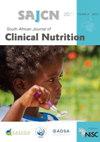在南非西开普省Stellenbosch市,对12-36个月儿童的母亲/照顾者进行南非儿童食品膳食指南修订草案的现场测试
IF 0.6
Q4 NUTRITION & DIETETICS
引用次数: 2
摘要
目的:评估修订后的南非儿童食品膳食指南草案(SA PFBDG)在12-16个月儿童的母亲/照顾者中的适用性和理解程度。还评估了接触具有类似信息的指导方针、障碍和遵循指导方针的促成因素。设计:进行描述性横断面定性研究。数据是从用伊西科萨语、英语和南非荷兰语进行的九次焦点小组讨论中收集的,共有65名参与者,20名来自正式领域,45名来自非正式领域。背景:斯泰伦博斯市(斯泰伦博斯赫、普尼尔和弗兰施霍克)受试者:研究人群包括同意参与的18岁以上的母亲/照顾者。结果:这项研究表明,参与者对修订后的SA PFBDG草案中包含的核心信息有了大致的理解。由于含糊不清,对某些准则产生了误解。参与者熟悉并认可由于之前的接触而传达的大多数概念,主要来自医疗机构和媒体。财政限制被认为是遵守指导方针的最大障碍,而被认为是推动因素包括接受有关指导方针的教育以及对指导方针的直观描述。结论:经过实地测试,很明显,修订后的SA PFBDG草案适用于12-36个月年龄组。需要进行细微的改写以增进理解。建议通过多个交流平台有效传播准则。本文章由计算机程序翻译,如有差异,请以英文原文为准。
Field testing of the revised, draft South African Paediatric Food-Based Dietary Guidelines among mothers/caregivers of children aged 12–36 months in the Stellenbosch Municipality in the Western Cape province, South Africa
Objective: To assess the appropriateness and understanding of the revised, draft South African Paediatric Food-Based Dietary Guidelines (SA-PFBDGs) among mothers/caregivers of children aged 12–36 months. Exposure to guidelines with similar messages, barriers and enablers to following of the guidelines were also assessed. Design: A descriptive cross-sectional qualitative study was conducted. Data were collected from nine focus-group discussions (FGDs) conducted in isiXhosa, English and Afrikaans, resulting in 65 participants, 20 from formal areas and 45 from informal areas. Setting: Stellenbosch Municipality (Stellenbosch, Pniel and Franschhoek) Subjects: The study population included mothers/caregivers older than 18 years, who consented to participate. Results: This study revealed that participants expressed a general understanding of the core messages contained in the revised, draft SA-PFBDGs. Misinterpretation arose regarding certain guidelines as a result of ambiguity. Participants were familiar with and recognised the majority of the concepts conveyed owing to previous exposure, mostly from healthcare facilities and the media. Financial constraints were identified as the biggest barrier to following the guidelines, while perceived enablers included receiving education on the guidelines as well as visual portrayal thereof. Conclusion: Following field-testing, it is clear that the draft, revised SA-PFBDGs for the age group 12–36 months are appropriate. Minor rewording is required to enhance understanding. Effective dissemination of the guidelines through multiple communication platforms is recommended.
求助全文
通过发布文献求助,成功后即可免费获取论文全文。
去求助
来源期刊

South African Journal of Clinical Nutrition
NUTRITION & DIETETICS-
CiteScore
2.50
自引率
9.10%
发文量
21
期刊介绍:
1.The Journal accepts articles from all basic and applied areas of dietetics and human nutrition, including clinical nutrition, community nutrition, food science, food policy, food service management, nutrition policy and public health nutrition. 2.The Journal has a broad interpretation of the field of nutrition and recognizes that there are many factors that determine nutritional status and that need to be the subject of scientific investigation and reported in the Journal. 3.The Journal seeks to serve a broad readership and to provide information that will be useful to the scientific community, the academic community, government and non-government stakeholders in the nutrition field, policy makers and industry.
 求助内容:
求助内容: 应助结果提醒方式:
应助结果提醒方式:


